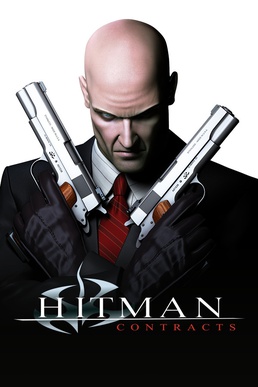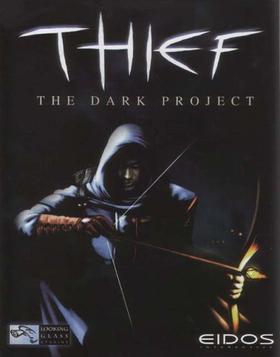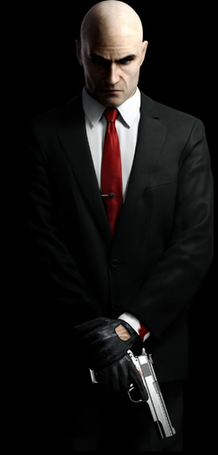
Hitman 2: Silent Assassin is a 2002 stealth video game developed by IO Interactive and published by Eidos Interactive for Microsoft Windows, PlayStation 2, Xbox and GameCube. The game was re-released for Windows through the Steam online distribution service, and a DRM-free version was later made available through GOG.com. It is the second installment in the Hitman video game series and the sequel to Hitman: Codename 47. The single-player story once again follows Agent 47, a genetically enhanced human clone who worked for the International Contract Agency (ICA) as an assassin. Following the events of Codename 47, the former contract killer has retired and started a peaceful life at a church, but after his only friend, Reverend Emilio Vittorio, is kidnapped by unknown assailants, 47 resumes work for the ICA in hopes of tracking him down.
A stealth game is a type of video game in which the player primarily uses stealth to avoid or overcome opponents. Games in the genre typically allow the player to remain undetected by hiding, sneaking, or using disguises. Some games allow the player to choose between a stealthy approach or directly attacking antagonists, but rewarding the player for greater use of stealth. The genre has employed espionage, counter-terrorism, and rogue themes, with protagonists that are special forces operatives, special agents, secret agents, thieves, ninjas, or assassins. Some games have also combined stealth elements with other genres, such as first-person shooters and also platformers.
Hitman is a stealth game franchise created by Danish developer IO Interactive. The player controls the contract killer Agent 47, who travels the world to assassinate various targets who are assigned to him.

Hitman: Contracts is a 2004 stealth video game developed by IO Interactive and published by Eidos Interactive for Microsoft Windows, PlayStation 2 and Xbox. It is the third installment in the Hitman video game series, and serves as both a remake of Hitman: Codename 47 and sequel to Hitman 2: Silent Assassin, incorporating gameplay elements introduced in the latter into missions from the first game, which have been remastered with enhanced graphics. The game also includes several new missions, which serve as flashbacks experienced by the player character, the cloned assassin Agent 47, after being almost killed on a botched job.
IO Interactive A/S (IOI) is a Danish video game developer based in Copenhagen, best known for creating and developing the Hitman and Kane and Lynch franchises. IO Interactive's most recent game is Hitman 3, which was released in January 2021.

Hitman: Blood Money is a 2006 stealth video game developed by IO Interactive and published by Eidos Interactive. It was released in May 2006 for Microsoft Windows, PlayStation 2, Xbox and Xbox 360. It is the fourth installment in the Hitman video game series, and the sequel to 2004's Hitman: Contracts. The story follows cloned assassin Agent 47's efforts to bring down the Franchise, a rival contract killing organization that is threatening his employers, the International Contract Agency (ICA), and seeking to obtain the same cloning technology that created 47. Meanwhile, a frame story presents 47's life and various contracts he carried out, as narrated by a former FBI director to a journalist.

Freedom Fighters is a 2003 third-person shooter video game for the PlayStation 2, GameCube, Xbox, and Microsoft Windows. It was developed by IO Interactive and published by Electronic Arts.

Thief: The Dark Project is a 1998 first-person stealth video game developed by Looking Glass Studios and published by Eidos Interactive. Set in a fantasy metropolis called the City, players take on the role of Garrett, a master thief trained by a secret society who, while carrying out a series of robberies, becomes embroiled in a complex plot that ultimately sees him attempting to prevent a great power from unleashing chaos on the world.

Agent 47 is a fictional character, the protagonist and the player character of the Hitman video game franchise, developed by IO Interactive. He has been featured in all games of the series, as well as various spin-off media, including two theatrically released films, a series of comics, and two novels. He has been voiced by actor David Bateson in every main entry in the series since its inception in 2000.

Thief II: The Metal Age is a 2000 stealth video game developed by Looking Glass Studios and published by Eidos Interactive. Like its predecessor Thief: The Dark Project, the game follows Garrett, a master thief who works in and around a steampunk metropolis called the City. The player assumes the role of Garrett as he unravels a conspiracy related to a new religious sect. Garrett takes on missions such as burglaries and frameups, while trying to avoid detection by guards and automated security.

Hitman: Absolution is a 2012 stealth video game developed by IO Interactive and published by Square Enix's European branch. It is the fifth installment in the Hitman series and the sequel to 2006's Hitman: Blood Money. Before release, the developers stated that Absolution would be easier to play and more accessible, while still retaining hardcore aspects of the franchise. The game was released on 20 November 2012 for Windows, PlayStation 3, and Xbox 360. On 15 May 2014, Hitman: Absolution – Elite Edition was released for OS X by Feral Interactive; it contains all previously released downloadable content, including Hitman: Sniper Challenge, a "making of" documentary, and a 72-page artbook. On 11 January 2019, Warner Bros. Interactive Entertainment released enhanced versions of Absolution and Blood Money for the PlayStation 4 and Xbox One as part of the Hitman HD Enhanced Collection.

Reto-Moto ApS was a Danish video game developer based in Copenhagen. Founded in 1997, its staff formed IO Interactive as a joint venture in September 1998. Following a decade of inactivity, some founders reformed Reto-Moto in April 2008, and the company developed Heroes & Generals, which was released in September 2016.

Deus Ex is a series of role-playing video games, set during the mid 21st century. Focusing on the conflict between secretive factions who wish to control the world by proxy, and the effects of transhumanistic attitudes and technologies in a dystopian near-future setting, the series also includes references to real-world conspiracy theories, historical mythologies and philosophies, and provides a commentary on capitalist values and division in society. The first two games in the series were developed by Ion Storm, and subsequent entries were developed by Eidos-Montréal, following Ion Storm's closure. The Ion Storm games were published by Eidos Interactive, and all Eidos-Montréal media was published by Square Enix until 2022, when ownership was sold to Embracer Group.
Jonas Eneroth is a video game producer, game designer and entrepreneur.

Hitman Go is a turn-based puzzle video game developed by Square Enix Montréal and published by Square Enix's European subsidiary. Announced in February 2014, the game was released for iOS in April 2014 and for Android in June 2014. Windows and Windows Phone versions were released the following year in April 2015. In February 2016, a "Definitive Edition" version was released on PlayStation 4, PlayStation Vita, and on Linux and Windows via Steam. It is the first game developed by Square Enix Montréal, a studio founded in 2011. Development entered full production in 2013 and was completed by eleven people using the Unity game engine.

Hitman is a 2016 stealth video game developed by IO Interactive and published by Square Enix. The game, which has six episodes, is the sixth mainline entry in the Hitman franchise, the first installment of the World of Assassination trilogy, and the successor to Hitman: Absolution (2012). The single-player story follows genetically engineered assassin Agent 47 as he goes on a worldwide adventure and solves a mysterious series of seemingly unconnected assassinations. Hitman features a number of large, open-ended sandboxes that Agent 47 can freely explore. The game presents the player with various assassination opportunities, many of which are unconventional. IO Interactive introduced a "live component" to the game with new content being regularly delivered in downloadable form.

Square Enix Montréal was a Canadian video game developer based in Montreal. It created the Go series of turn-based puzzle games for mobile devices based on former Eidos Interactive intellectual properties.

Hitman 2 is a 2018 stealth video game developed by IO Interactive. It is the seventh main installment in the Hitman video game series, the sequel to 2016's Hitman and the second game in the World of Assassination trilogy. The game continues the story arc started in Hitman, following genetically engineered assassin Agent 47 as he searches for the mysterious "Shadow Client" who is trying to destroy Providence, a secretive organization that controls global affairs. It also explores more of 47's mysterious background, which Providence offered to bring to light in exchange for 47's assistance. Like its predecessor, the game is structured around six large sandbox locations that players can freely explore to find opportunities to eliminate their targets. It also included two online multiplayer modes called Sniper Assassin and Ghost Mode, though the game's servers for both modes have since been shut down; Sniper Assassin can still be played single-player.

Hitman 3 is a 2021 stealth game developed and published by IO Interactive. It is the eighth main installment in the Hitman video game series, the sequel to 2018's Hitman 2, and the third entry in the World of Assassination trilogy. Concluding the story arc started in 2016's Hitman, the game follows genetically engineered assassin Agent 47 and his allies as they hunt down the leaders of the secretive organization Providence, which controls global affairs and was partially responsible for 47's creation and upbringing. Like its two predecessors, the game is structured around six levels, five of which are large sandbox locations that players can freely explore to find opportunities to eliminate their targets. Each mission presents challenges that players can complete to unlock items.

Sapienza is a fictional Italian town from IO Interactive's Hitman video game franchise. First appearing in Episode 2: Sapienza of the 2016 video game Hitman, Sapienza was modeled after the Ligurian comune Vernazza as well as various towns along the Amalfi Coast in Southern Italy, and is similarly presented as a popular tourist destination like its real life counterparts. The levels of Hitman were originally released in episodic format, with Episode 2: Sapienza following Episode 1: Paris. In Episode 2, the player character Agent 47 travels to Sapienza in order to terminate a deadly biological weapon and its creator. Players may take advantage of "Opportunities", story driven threads scattered around the level that 47 can use to manipulate and kill targets. The sparsely populated town's peaceful environment and relaxed "siesta" ambience is intended to offer freedom of exploration, a deliberate choice to let players discover at their own pace weapons, secret routes and story threads that they could leverage in order to achieve the main objectives. Sapienza reappears in further levels which were subsequently introduced by Hitman developers, such as the bonus episode "The Icon", where the town center is reimagined as a movie set run by an assassination target.
















